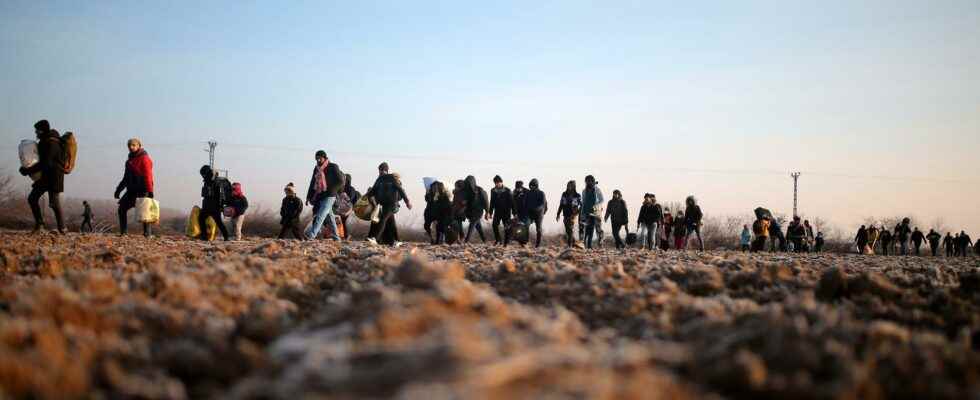Published: Less than 10 min ago
full screen
Next
Millions of people will have to move because of climate change and natural disasters, a new report shows.
1 of 2 Photo: Emre Tazegul/AP/TT
As many as 175 million people could be forced to move as a result of climate change by the year 2050.
– We need to prepare for an uncertain future, says migration researcher Rainer Münz.
Hundreds of millions of people have already been forced to move due to climate change and natural disasters. Hundreds of millions more may have to do the same in the coming decades, according to a new report by the independent committee Delegation for Migration Studies (Delmi).
– We wanted to look at what we know going forward and what we know right now, previous estimates have been greatly exaggerated. What we do know is that approximately 344 million people have had to move in some form directly after a natural disaster between 2008 and 2021, says Daniel Silberstein, investigative secretary at Delmi.
How many have moved, or will have to, due to slow climate change, such as droughts and floods, is all the more difficult to know. Among other things, because it is difficult to isolate climate change as a single cause of migration, according to Daniel Silberstein.
– It will be an indirect factor. It could be drought or the disappearance of farmland that causes people to move. Often when people become mobile they do not cite climate change as the reason for migration. They say more “we can’t make a living here anymore, that’s why we’re moving”.
Great uncertainty for the future
Forecasts for future movements due to slow climate change are therefore also uncertain.
The World Bank estimates that 78-175 million people will be forced to move by the year 2050. The lower figure is based on if the average temperature rises by 1.5 degrees. The higher figure if the average temperature would rise by 4 degrees. Several other parameters contribute to the uncertainty factor, says Daniel Silberstein.
– It also depends on whether states are willing and able to implement projects to adapt and mitigate the effect of climate change. That is an extremely central question in this.
He cites the Netherlands as an example of a country that has been able to adapt by building dams so that people can continue to live in areas below sea level.
– But many countries do not have the opportunity to do so, those that do not have the financial conditions.
Contributes to urbanization
The majority of those who have been forced to move as a result of climate-related natural disasters have been able to move back to their homes, or at least to the region they came from. A very small part, 6 million, could not return to their home region, according to researcher Rainer Münz.
– Although many have been able to return, it is a problem. Two billion people have moved from rural areas to cities in the past 40 years, partly due to climate change. It can lead to overpopulated cities and difficulties with infrastructure, he says.
What it looks like for those who have moved due to slow climate change is not known.
– What is known is that this is not a driving force for international migration as it has been assumed to be in the past. But if climate-related natural disasters increase, things may look different in the future, says Daniel Silberstein.
Far more people are affected
However, the number of people who will be affected by climate change and related natural disasters is far more than the number who will be forced to move, according to the researchers behind the report. Between 3.3 and 3.7 billion people will be vulnerable to climate change by 2050 because they live in regions at risk of extreme weather conditions, the researchers predict. That would correspond to 30 to 40 percent of the population.
– Not everyone will want or be able to move. On the one hand, people will find ways to deal with a changing climate, and on the other hand, many will not be able to afford to move. Some will rather be forced to stay despite difficult conditions, says Rainer Münz.
How people are affected by climate change will be unevenly distributed, according to the report. Low- and middle-income countries will be the most affected because the population largely earns its living through cultivation and has less economic opportunities to move. You need to ensure that political measures are also in place for those who do not migrate due to climate change, says Daniel Silberstein.
– We have to take in the whole picture and keep this large group in mind, who are not forced or do not have the opportunity to move but who are exposed to risks. This is a group that must not be forgotten, because it will be the large group that needs support.
Facts
Report on climate change
The report ( Climate change, displacement, mobility and migration: the current state of research, future scenarios and policy options ) is a knowledge overview based on previous research and is published by the Delegation for Migration Studies (Delmi).
Responsible investigative secretary has been Daniel Silberstein.
The authors:
Mathias Czaika, Professor of Migration and Integration and Head of the Department of Migration and Globalization at Danube University, Krems, Austria.
Rainer Münz, expert on demography and international migration. He is currently a visiting professor at the Central European University and the Diplomacv Academy in Vienna, Austria.
Source: Delmi
Read more
